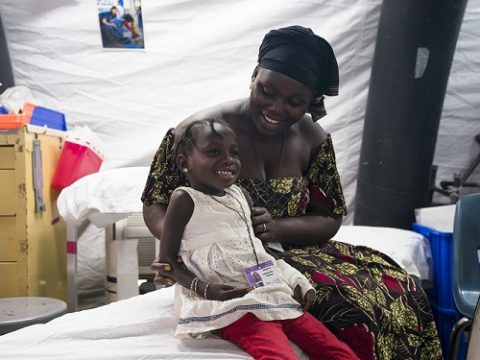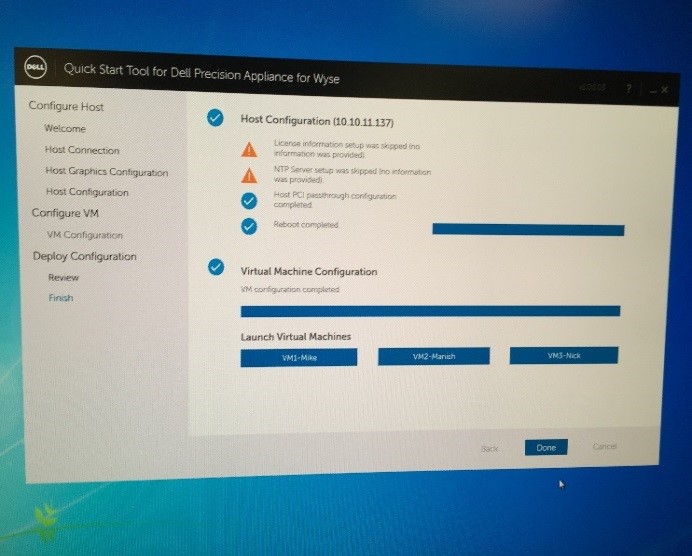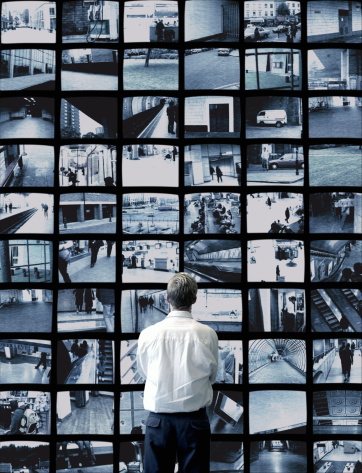Ninety-three percent of sub-Saharan Africans have no access to surgical care. Mercy Ships is working to address this need by providing free surgeries and training to countries developing their capacity in global surgery. These medical volunteers have provided more than 100,000 free surgical procedures–like correcting Kadiatou’s clubbed feet–since 1978. Africa Mercy, the world’s largest civilian hospital ship, is based in Dakar, Senegal until 2020. In an interview with Dell Technologies, Mercy Ships CIO Chris Gregg shares the importance of simplicity and the technology behind the organization’s heroic mission.

Tell us a little bit about Mercy Ships. How does the organization work and operate?
CHRIS GREGG: We run hospital ships that are staffed by volunteers that will partner with a country providing free surgical care and training to healthcare professionals in the country. The patients we serve are often those that are outcasts from society who don’t have access to healthcare and have often struggled for years with the conditions they face.
Often these people are facing a life with no hope because they haven’t had access to surgery. For example, a child who is blind won’t be able to go to school, won’t be able to have a job, and his or her future looks bleak. Often many of these patients will have shortened lives because they don’t have access to the care, and the opportunities for healthcare. So, we offer them an opportunity, a hope for surgery that otherwise they wouldn’t have, and we provide that free of charge.
How did you first become involved with Mercy Ships? What’s happening on board that makes that commitment so strong?
CG: I first got involved with Mercy Ships as a volunteer and spent some time with my wife volunteering on our first hospital ship and actually ended up spending four years working as a volunteer. We started to raise a family. Our oldest son spent his first 18 months on board with us.
“Being a part of Mercy Ships is an opportunity to show that these people are cared for and valued, that there is hope for them, that they are not forgotten, and there are opportunities for them to have their lives restored.”
—Chris Gregg, CIO, Mercy Ships
Being a part of Mercy Ships is an opportunity to show that these people are cared for and valued, that there is hope for them, that they are not forgotten, and there are opportunities for them to have their lives restored. And not just that, but also as we deliver training, when also addressing the systematic issues that are there as well. So, for me and for our family, that has been a foundation, being able to show that these people are valued and are cared for, even the most forgotten people in society in those developing nations.
I’ve been with Mercy Ships for almost 20 years, and I continue to see that we make a huge impact. I see in Mercy Ships an ability to really impact the challenges that are out there through providing not only health care but also providing training.
Your wife, Vicki, is a nurse and an obvious fit for the volunteer team. By contrast, you’re an IT engineer. How did you fit into the ship ecosystem?
CG: As we’ve gotten to know the organization, what quickly became apparent to us is we need professionals of all types on board. It’s a hospital, of course, but it’s a hospital running on a ship. It’s a small community. We have skill sets from accountants and HR and IT. There is a whole range of people working there, and often, many of the difficult positions to fill are not the medical positions. They are some of the technical positions.
As the CIO leading the information services team, it directly supports and underpins that work, and it’s incredibly valuable and fulfilling to do that. And while I’m not on the front line, what I do has this impact down the road in supporting the hospital and its services. Visiting the frontlines makes that connection again with the work we are supporting.
What’s life like for volunteers onboard the Africa Mercy?
CG: There’s a diverse group of people working on the ship, coming from countries all over the world. Last year, we had 58 countries represented. So there’s this really unique environment of people from all over the world, all backgrounds and ages, all committed to a common purpose of serving and addressing the needs and showing that compassion and care for the patients.
What are the most important goals for the IT department at Mercy Ships?
CG: We want to ensure that the hospital, the supply chain, finance and HR are effectively running. As an information services department, ensuring our internal customers are properly supported is a key piece.
Secondly, we want to ensure that we are aligning what we do to the strategy of the organization and providing the right innovation to help us grow and be more effective.
Thirdly, we want to ensure that we are running effectively and that all of the operations that we provide as an IT department are supporting effective operations of the entire organization. We want to be good financial stewards and manage our finances with integrity, within IT.
And lastly, we want to ensure that our team is healthy and that our team is able to function well as a group of people. When we function well, we’re able to support the organization more effectively.
What are some of the biggest challenges you face in your role?
CG: This organization is fairly complicated in that we are running hospitals on ships with volunteers and a distant supply chain. I would say the largest challenge we have, from an IT perspective, is maintaining simplicity among all of that complexity.
“This organization is fairly complicated in that we are running hospitals on ships with volunteers and a distant supply chain. I would say the largest challenge we have, from an IT perspective, is maintaining simplicity among all of that complexity.”
Looking at the technology, we want to ensure that the decisions we make are driving toward simplifying, consolidating and standardizing so that we can focus more on improving the operations of the organization and ultimately delivering more services and impacting more people.
The simplicity of the technology is important because we want to focus on delivering the healthcare. We don’t want to focus on building IT. We want to focus on adding value to the organization and improving what we do and increasing the impact of what we do.
So that means looking at how the hospital can be more effective rather than how the data center’s more effective, looking at how we strengthen communication across the organization rather than building an email system, for example. So we want to ensure that the technology is simple so that we can focus our energies with the resources that we have on improving the organization’s effectiveness.
What’s been the primary driver for Mercy Ships’ IT transformation?
CG: The primary driver for the IT transformation has been the growth of the organization. As we bring on a second ship [next year], all of the organization has been stretching and growing and so much of that is built on having an IT structure that can support that growth.
As we’ve looked at what we’ve needed to do, we’ve been looking at how to simplify our infrastructure so we can focus on the growth of the organization ready to operate two ships and what we need to do in terms of running our departments so that we can effectively serve the organization as we scale up.
How are you transforming your IT infrastructure to do that?
CG: Historically, we’ve come from a traditional data center model, but as we looked at the needs for the future and particularly in looking to simplify and consolidate our data centers, having a modern infrastructure approach was really important.
“As we focused on growth, we didn’t want to focus so much on building an IT infrastructure in the data center. We wanted to take a new approach. We wanted to take a hybrid cloud approach.”
As we focused on growth, we didn’t want to focus so much on building an IT infrastructure in the data center. We wanted to take a new approach. We wanted to take a hybrid cloud approach. Being able to do that on a single platform in an integrated environment is very valuable to us. Our goal is being able to manage our environment seamlessly across the on-premise data centers on ship, along with the cloud environment.
Our vision for the data center is to continue the journey from the traditional architecture toward essentially a cloud platform with a mixture of on-premise private cloud and public cloud. With operating data centers on the ship, we need to keep on-premise. But as we look at the strategy for our support operations, we don’t want to continue building data centers and maintaining data centers here in our International Support Center in Texas.
Does that modern infrastructure directly impact the people working on the front lines in the ships?
CG: Bringing in a hyperconverged approach will allow us to have the IT team focused much more on customer service to the hospital on board, and our team members are able to more effectively support hospital operations rather than spending their time focused on IT in the data centers onboard.
It also has allowed our team at the support center to remotely manage with data centers onboard and not necessarily rely as much on the team on board. It’s allowed our small team of volunteer IT staff to focus more on that direct customer service.
Learn how Mercy Ships has impacted hundreds of thousands of lives here.








